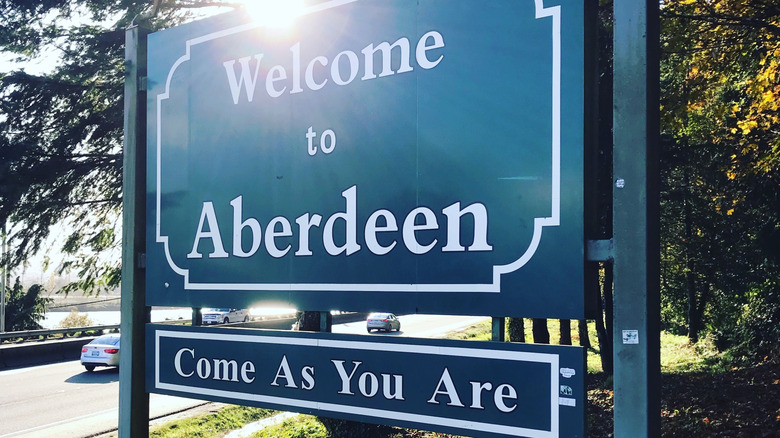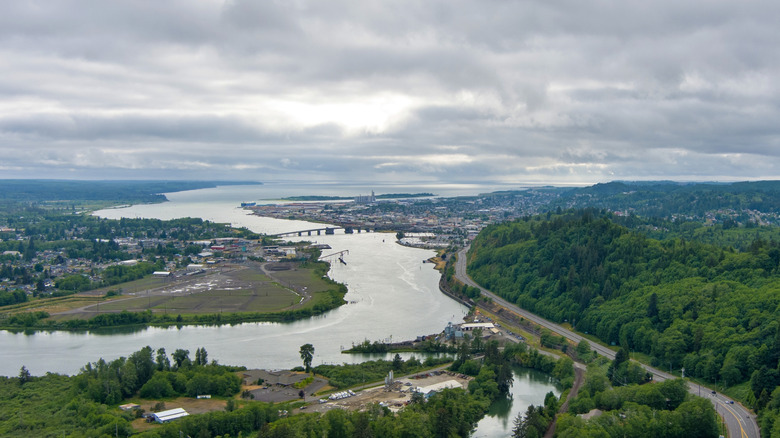A Washington City Once Called 'Hellhole Of The Pacific' Has A Gritty, Colorful History And Outdoors Galore
If you've ever been to Washington, you know the state is full of idyllic cities, lush green spaces, and plenty of wide-open land. Virtually every spot within the state is perfect for a vacation, whether you're looking for a big metropolis or a quaint small town. But what if you could visit the "Hellhole of the Pacific?" Would you be intrigued? Well, that's Aberdeen, a.k.a. the former home of Nirvana frontman Kurt Cobain. Thankfully, Aberdeen is far from a "hellhole" today, but remnants of its sordid past are still present, even if they're almost invisible.
Nestled at the inner edge of North Bay, just about 30 minutes away from the gorgeous coastal city with expansive beaches and kite-friendly breezes, Aberdeen is the quintessential riverside town. With laid-back vibes and plenty of outdoor activities, it's hard to believe the city used to house some of the roughest and toughest folks of the past.
So, if you're looking for a cozy vacation spot that puts you close to some of the best scenery Washington has to offer, Aberdeen should be at the top of your list.
Why was Aberdeen considered the 'Hellhole of the Pacific?'
When looking at the map, it's easy to see why Aberdeen was such a major economic hub at the turn of the 20th century. Its position at the head of the Chehalis River and the mouth of the North Bay meant ships could come in and out with ease, sending goods and people down the river toward Portland to the south. Heavy industry meant a large number of working-class men who needed various ways to blow off steam and spend their wages.
So, many illicit businesses set up shop in and around Aberdeen, including brothels, saloons, and gambling halls. It wasn't long before the city gained a nasty reputation, earning the title "Hellhole of the Pacific." But it wasn't just the sordid establishments that made Aberdeen infamous. In addition to "hellhole," the city was also known as the "Port of Missing Men," thanks to its alarmingly high murder rate.
While Aberdeen's troubles would continue through the Great Depression and into the 1980s, it would be transformed by an unlikely resident. Although he wasn't born in Aberdeen, Kurt Cobain grew up in the city, giving it a newer, more palatable nickname, "the Birthplace of Grunge." Today, Aberdeen continues to celebrate Cobain's and Nirvana's cultural relevance, with a band lyric on the official welcome sign, "Come As You Are," and placing Cobain's childhood home on the state's Heritage Register.
Planning a trip to the new and improved Aberdeen, Washington
Gone are the bordellos, saloons, and infamous murder rates. The Aberdeen of today is much quieter and more family-friendly, making it a fantastic place to stop for a weekend. The easiest way to reach Aberdeen is by flying into the Seattle-Tacoma International Airport and driving about 100 miles west toward the coast. Along the way, you'll pass by Steilacoom, Washington's oldest town and an overlooked gem with cute waterfront parks.
While there are multiple hotels and inns within Aberdeen, you might want to camp here instead. One of the best campsites in the United States (according to HipCamp) is Unique Bay Front Camping, which offers waterside views and well-kept grounds. The city is also close to other gorgeous outdoor sites, like the Olympic National Forest and Capitol State Forest, which offer camping, hiking, biking, boating, hunting, and fishing opportunities. If you prefer the coast, it's right on your doorstep. Plus, you're only 90 minutes from the Washington beach that holds the record as the longest in America.
Although outdoor recreation is a big part of Aberdeen's appeal, the city itself is full of hidden gems. When you get hungry, there's a diverse selection of fabulous restaurants. For local Pacific Northwest fare, try Rediviva. If you prefer a good old-fashioned hot dog, 'Deen Dogs is a guilty pleasure. Or, since you're near the coast, indulge in some fresh seafood at Breakwater Seafood and Chowder House, which overlooks the Wishkah River where it meets the Chehalis.


